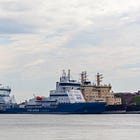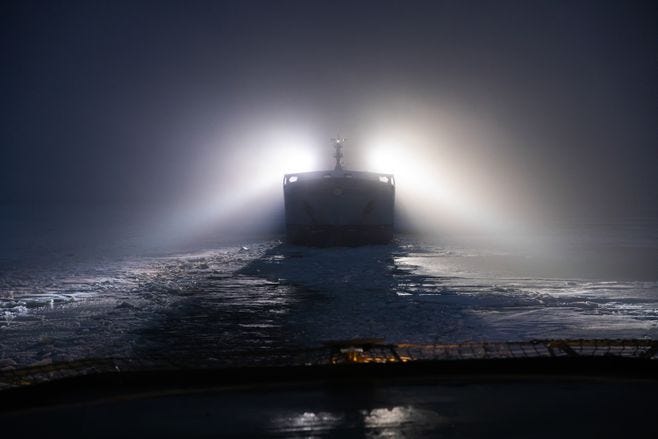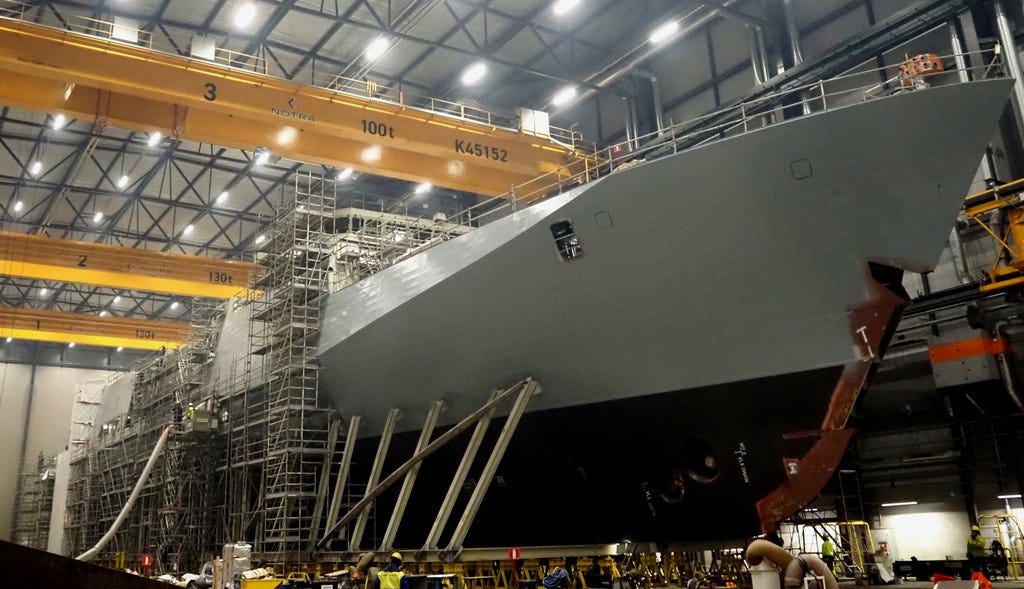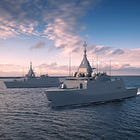European Icebreaking Roundup
A look at some of the smaller stories that my readers may have missed.
Today, Sixty Degrees North brings you a round-up of recent icebreaker news from around Europe. This does not include the larger stories that we’ve been tracking, such as the Polarstern 2 project, which warrant their own article.
Baltic Icebreaking Season Update:
Despite a very mild winter, icebreaking season continues in the Bay of Bothnia.
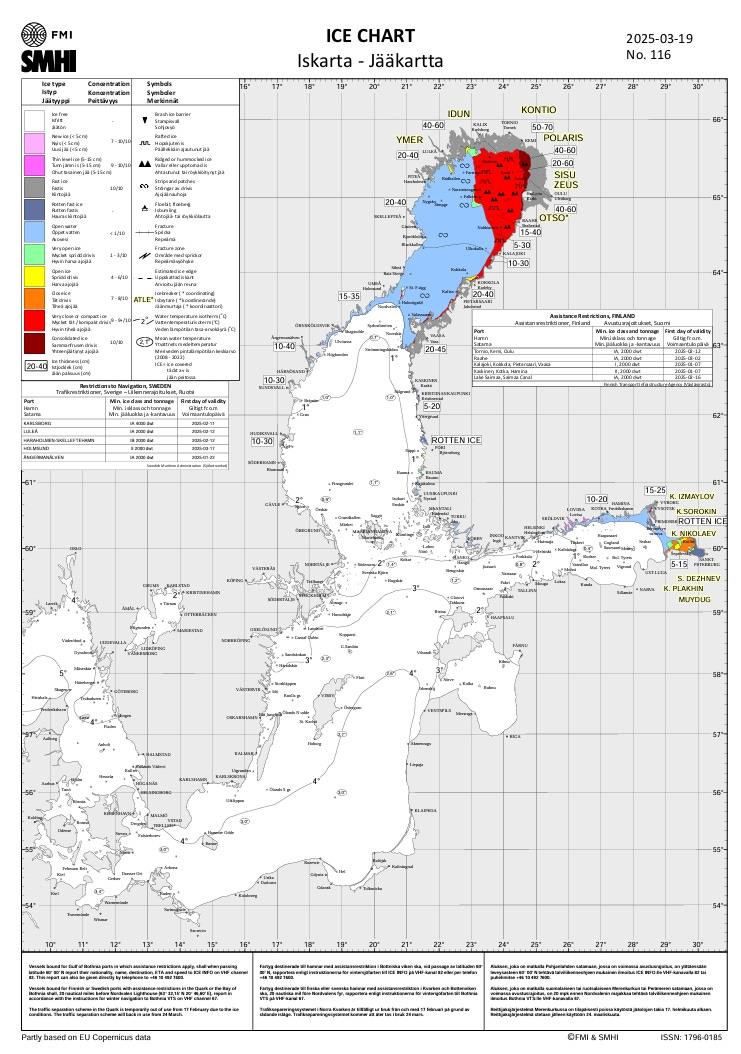
Ice in the Baltic is not like the ice you might see covering a lake. As a strong wind creates waves, it also affects ice- pushing drifting ice until it meets an object. In the Bay of Bothnia strong winds, normally from the southwest, push the ice towards the northeast. When the moving ice comes into contact with fixed objects such as ships, the pressure of the ice can damage the vessel. When it comes into contact with immovable ice- fast ice attached to the land- it packs tightly and forms ridges:
Drift ice can easily become packed when it reaches an obstacle. Typically, this occurs when the ice field moves against the fast ice edge. In the shallows, ridges get anchored to the bottom and the visible parts can grow to tens of meters high. Ridged ice appears also in the middle of seas where the ice floes get pressed against each other and break into pieces. The pieces of ice pile up over and under the sea surface forming meandering ice ridges. (Ilmatieteenlaitos)
These ridges can be tens of meters high, creating very challenging conditions for the icebreakers.
At the moment, there are four Finnish icebreakers (Otso, Kontio, Sisu, and Polaris), the Finnish icebreaking tug Zeus, and two Swedish icebreakers (Atle and Idun) operating in the Bay of Bothnia to ensure that the ports remain open.
This marks the first use of Idun, which the Swedish Maritime Administration purchased last year and then modified (including the addition of a towing notch) for use in assistance icebreaking.
You can read more about Idun here and the Finnish icebreakers here:
Underway on a Finnish Icebreaker: Media Event
Arctia, the state-owned operator of Finland’s icebreaking fleet, hosted journalists aboard the icebreaker Sisu for several days at the end of February. Several good articles resulted from this media experience1.
YLE, Finland’s state-owned broadcaster:
YLE reporter Matthew Schilke penned an in-depth article that not only followed Sisu’s icebreaking activities, but also described Finland’s icebreaker industry and considered the possibility of a future deal with the United States regarding icebreaker construction:
I strongly recommend taking the time to read the article (and not just because I was interviewed for it!) I don’t agree with everything in the article, but it’s definitely one of the better overviews available.
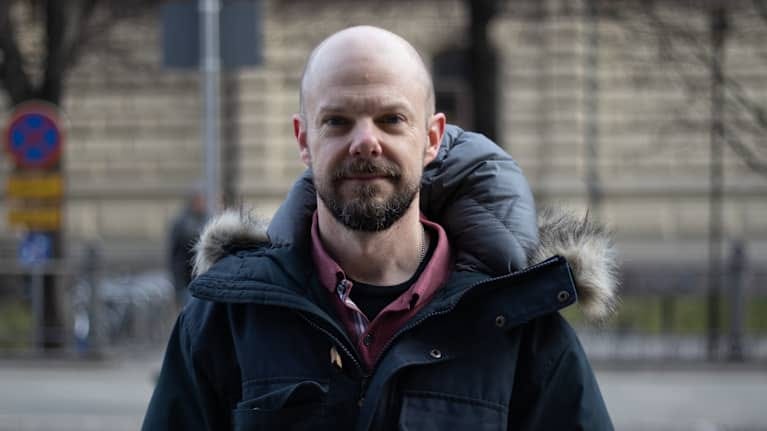
Helsingin Sanomat (HS, or Hesari):
Helsingin Sanomat, Finland’s largest circulation newspaper, also participated in the media event. The resulting article includes some great photos and videos of icebreakers working in dark and foggy conditions as well as a description of how the nearly 50-year old icebreaker Sisu broke the tanker EK Stream free from heavily ridged ice. And of course, a look at the day-to-day operations of Finnish icebreakers, including the people who make them work.
The headline, and its translation: (Note the Finnish word sisu2!)
With Sisu and Heart.
Strong Wind. Dark Night. Pea-soup Fog. Ice 30 meters from the surface to the bottom. Finnish shipping traffic travels in conditions that are difficult to even imagine.
The article is in Finnish and behind a paywall, but HS allows for a free trial- and mechanical translators seem to do a fair (but not perfect) job in translating the article into English.
HBL:
HBL, the newspaper that published an interview with me back in February- also participated in the Arctia media event. Their story- unfortunately, behind a paywall (and in Swedish) is available here.
Hull of Finland’s first Pohjanmaa-Class Corvette completed
Rauma Marine Constructions (RMC) announced on January 31st, 2025, that the hull of the first Pohjanmaa-class multi-mission corvette had been completed.
RMC is building four multi-mission corvettes for the Finnish Navy. The 1.3 Billion Euro program, also known as the “Squadron 2020 project,” will replace seven aging vessels: four Rauma-class fast-attack missile boats, two Hämeenmaa-class minelayers, and the already decommissioned minelayer Pohjanmaa.
For more information on Finland’s multi-mission corvettes, see:
Aker Arctic Conducted Ice Model Testing for U.S. Coast Guard’s Great Lakes Icebreaker Program
It seems that reporters here in Finland figured out how to use the USASpending.gov website. One resulting articles pointed out that the U.S. Government had a recent contract with Aker Arctic, a Finnish company known for designing icebreakers, valued at about $1.5 million.
The referenced contract is for ice model testing for the Great Lakes icebreaking program:
According to recent Congressional Testimony, the U.S. Coast Guard is still years away from having a conceptual design for the next Great Lakes Icebreaker. It will require $25 million in FY 2025 and $35 million in FY 26 to “complete analysis.” (VADM Allan, March 5, 2025 Congressional Testimony).
As hull form testing is already ongoing, perhaps the U.S. Coast Guard could beat that deadline. If it takes Helsinki Shipyard three years to build an icebreaker, it shouldn’t take the U.S. Coast Guard two years to analyze the need. After all, it’s been breaking ice on the Great Lakes for quite some time…
Swedish Maritime Agency Facing Budget Crisis, Icebreaker Might be Laid Up
According to this article (English version here), the Swedish Maritime Administration lost SEK 600 million in 2024, and an even greater loss is expected this year. Unless the government increases its appropriation, the agency will make drastic cuts to its services:
Through the disposal of vessels, the possibility of heavy fairway maintenance and surveying is halved. An icebreaker is being laid up, which risks leading to closed fairways and ports. As shipping accounts for nine out of ten transports of Swedish imports and exports, longer waiting times for icebreakers and the risk of closed ports can affect the Swedish basic industry in the north.
Two out of five helicopter bases for sea and air rescue are planned to be closed. This will mean longer response times and that the Air Force will not be able to train as it does today.
“The measures decided will have a direct impact on both our customers and our employees. The measures are not something we want to implement, but we are in a serious financial situation that makes it necessary,” says Erik Eklund, Director General.
The Swedish Maritime Administration outlined these cuts in a plan that was scheduled to be proposed to the Swedish government on March 1st. This is not the last word on the matter:
To save the situation, the Swedish Maritime Administration is requesting an annual increase in government funding of SEK 250 million, the possibility of increasing fees by SEK 250 million and that the government’s investments in maritime infrastructure and the shipping fleet should amount to SEK 35 billion over a ten-year period. This also includes the operation of the icebreakers in the same way that the state is responsible for snow clearance on roads and railways.
It seems odd that the SMA is planning on sidelining an icebreaker to save money at the same time it is in the process of procuring a new icebreaker. But that’s how government programs sometimes go- funds are appropriated specifically for new items that garner headlines, while day-to-day operations remain underfunded.
Estonia Planning New Icebreaker
Estonia is applying for EU funds to replace one of its aging icebreakers (original in Estonian, translated mechanically using Microsoft Bing):
The State Fleet is applying for funding from the Connecting Europe Facility (CEF) transport measure for the construction of a new environmentally friendly icebreaker. The price of the icebreaker needed by Estonia is nearly 122 million euros, and the corresponding measure would cover about half of the construction costs. The rest will have to be found from the state budget.
At present, Estonia has at its disposal three vessels with icebreaking capability: Tarmo, Eva-316 and the state-chartered Botnica. Of these, Eva-316 operates mainly in Pärnu Bay, the other two in the Gulf of Finland. At the same time, Tarmo's service, built in 1963, will end in 2028, according to current plans.
According to the Director General of the State Navy, the new icebreaker should be specially adapted to local conditions and be able to operate as needed in the Gulf of Finland, as well as, for example, in Pärnu Bay with significantly shallower water. In addition to icebreaking, the ship could also perform other functions, such as supporting pollution control, rescue work and research. The design of the new icebreaker must also take into account environmental requirements, including the use of alternative fuels.
Thoughts and Comments
Taken as a whole, these articles demonstrate why common design icebreakers are not, well, common. Estonia does not need the same capabilities and Finland and Sweden, so there is no need to pay for what is not needed. The conditions in the Bay of Bothnia- shallow, dark, and challenging- require different ships (and frequent crew rotation!) than research icebreakers.
Government budgets are tight, as indicated by the consistent funding problems of the Swedish Maritime Administration. The earlier decision- to procure only a single icebreaker now, instead of the planned two- was also related to a budget shortfall.
Still, the needs are there. Modern merchant vessels are larger and less powerful in order to comply with environmental regulations. This serves only to increase the burden on icebreakers as the fleets continue to age.
The ability to cost-effectively design and build icebreakers for all of these different needs is one of the reasons that Finland has a comparative advantage in this field.
I am working on an article describing in general terms the process by which Finnish companies do this- turning out custom-designed icebreakers in a fraction of the time and cost of other locations. Yes, Korea and Japan are also capable shipbuilders- but their comparative advantage seems to be in volume- i.e. in building large numbers of similar vessels, not small runs of custom designs.
I will soon start the ‘icebreaker of the week’ column. And, once more information is available, I intend to compare the four Polar Class 2 vessels currently under contract- the U.S. Coast Guard’s Polar Security Cutter, the two Canadian icebreakers, and the Polarstern 2.
Subscribe now so you won’t miss any of these coming articles, as well as other analysis based on the news of the day.
All the Best,
PGR
I was invited to come along but had a scheduling conflict. Thank you to Arctia for inviting me. I am looking forward to an opportunity to see your ships at work.
Sisu is a Finnish word often considered to be untranslatable into English. According to an article in Time magazine from January of 1940 (during the Winter War):
The Finns have something they call sisu. It is a compound of bravado and bravery, of ferocity and tenacity, of the ability to keep fighting after most people would have quit, and to fight with the will to win. The Finns translate sisu as "the Finnish spirit," but it is a much more gutful word than that.
Last week the Finns gave the world a good example of sisu by carrying the war into Russian territory on one front while on another they withstood merciless attacks by a reinforced Russian Army.




